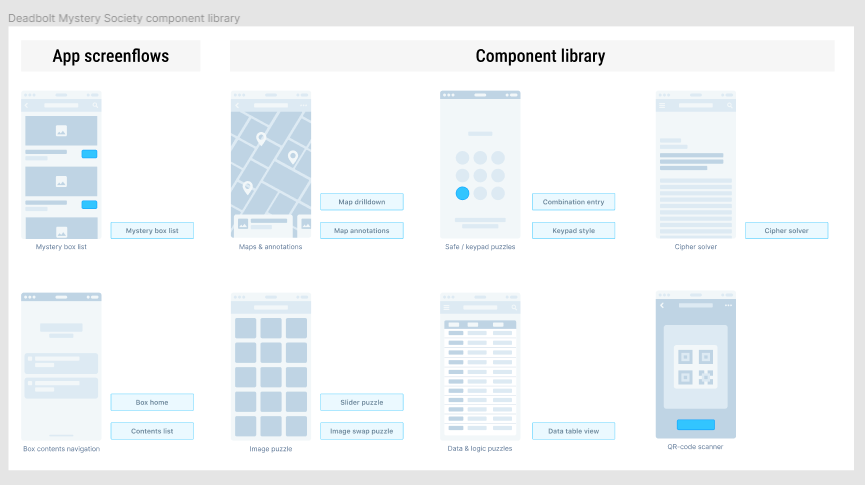Case Study
Mystery Game Design System
During the pandemic, my husband and I (already board game aficionados) discovered the world of “solve at home” mysteries…and everyone we know decided to gift them to us! But some experiences are better than others…

Problem:
One “solve at home” mystery subscription service comes from a company called the Deadbolt Mystery Society. Their game narrative design is spot-on, monthly mysteries leverage engaging themes, and their puzzles are enjoyably challenging.
But unlike rival companies like Hunt A Killer or Scarlet Envelope, the frustration of using the technology solution supporting the Deadbolt Mystery Society games significantly detracts from our enjoyment of the gameplay.
For example:
- Printed representations of tactile objects like slider puzzles on postcards and rely on human memory to “solve” the multi-step puzzle without supporting tools
- Password-protected PDFs for all combination lock-style puzzles, which provides zero user feedback except “wrong” or “right”
- Seemingly arbitrary modality (physical printed materials in the box vs. digital materials) for puzzles or information
Solutions like this scream “minimally viable product”. Except they’ve been in business for years with zero improvements. (Relatives have gifted us their boxes for almost 2 years, so despite our backlog, we occasionally play the newest box to check in to see if they’ve improved anything: they have not.)
I finally got fed up and decided to put my “money” (i.e. design hours) where my mouth is and solve the problem, rather than continuing to simply complain about it.
Challenge:
To create a versatile design system that would support the recurring types of puzzles offered by Deadbolt Mystery Society, while providing the kind of end-user experience that rival companies had trained frequent mystery box customers to expect.
Persona:
Gamers who love solving mysteries and puzzles, visiting escape rooms, and trying to guess the killer before the end of crime movies and shows. As of 2022, these folks are technologically savvy, and either grew up with computers and mobile phones from teen years (Gen X & Gen Y) or are true digital natives, so they expect more from a hybrid gaming experience than clunky password-protected PDFs.
Discovery:
But how does a UX Designer determine requirements when the “client” doesn’t even know she’s working on the project? (And, let’s be honest, might be insulted if they knew she was.)
In this rare case, I am my user. At least, one of my users, so I can certainly start with my own background knowledge of solving mystery boxes both from Deadbolt Mystery Society and other companies.
For the rest: look to the product! By analyzing (and playing) the game boxes themselves, I learn what types of mystery experiences the company wants to provide.
And this is an ongoing process. My husband and I only have a single “Mystery Monday” each week, and our backlog of other Kickstarter mysteries rivals even that of our Deadbolt Mystery Society boxes, so we’ll be playing these for some time. As I learn more, I’ll keep expanding the design system.
Component Design:
My current batch of design system components includes mobile-first designs (support for other screen sizes pending) for some of the most common types of puzzles used for solve-at-home mystery boxes.
- Introduction: Project overview (THIS PAGE)
- Screenflow: Tracking mystery boxes and buying new ones
- Screenflow: Mystery box home screen and component list
- Component: Maps + annotation functionality
- Component: Locks (2 variants)
- Component: Cipher solver
- Component: Image puzzles (2 variants – PENDING)
- Component: Logic puzzle grid (PENDING)
- Component: QR Code scanner (PENDING)
Future Plans:
My “mystery box design system” is an evolving project. At the moment, my top to-do list items include:
- More components
- Support for additional screen sizes
- Component admin screens
However, I still need to determine my ultimate goal for this project. Because as much as my frustrations with the Deadbolt Mystery Society digital solutions inspired this project, my understanding of the component library needed for mystery boxes evolves with every game we play.
Will I eventually offer my solution directly to Deadbolt Mystery Society?
Will I create my own technology stack and license it out or create my own games?
I truly don’t know. For now, it’s mostly a thought experiment. And a copyright. 🙂